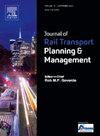基于二元分布函数的拥挤地铁站列车停留时间模型
IF 2.7
Q3 TRANSPORTATION
Journal of Rail Transport Planning & Management
Pub Date : 2025-08-16
DOI:10.1016/j.jrtpm.2025.100538
引用次数: 0
摘要
在客流量大的车站,由于乘客行为和相互作用的变化,列车停留时间复杂且不一致。虽然有几项研究调查了影响停留时间的因素,并开发了预测模型,但这些模型往往难以准确预测高客运量条件下的停留时间。这对在拥挤的环境中规划有效的时间表提出了重大挑战。考虑到这种可变性,使用基于概率的方法来预测停留时间延迟可以提供更好的规划。虽然一些研究已经确定了停留时间概率分布函数,但它们通常不包括客运量水平作为变量,限制了它们在高密度车站的适用性。本文通过对实际运行数据的研究,揭示了高客流量车站停留时间预测的局限性。为了解决这一差距,本文提出了一个包含客运量作为关键变量的二元概率函数。这给了我们一个更可靠的框架来预测拥挤环境中的停留时间延迟。使用Kolmogorov-Smirnov (K-S)检验来验证二元停留时间函数。这显示了该函数预测实现目标停留时间概率的能力,这对于规划停留时间至关重要。此外,该模型可以与延误影响评估一起应用,促进进一步的风险评估框架,可用于在时间表中设置停留时间时做出更明智的决策。本文章由计算机程序翻译,如有差异,请以英文原文为准。
Train dwell time models for crowded metro stations using a bivariate distribution function
Train dwell times at high-passenger-volume stations are complex and inconsistent due to variations in passenger behaviour and interactions. While several studies have examined factors affecting dwell time and developed models to predict it, these models often struggle to accurately predict dwell times under high passenger volume conditions. This poses significant challenges to planning effective timetables in crowded environments. Given this variability, using probability-based approaches to predict dwell time delay could provide better planning. Although some studies have identified dwell time probability distribution functions, they generally do not include passenger volume level as a variable, limiting their applicability in high-density stations.
This paper investigates actual operational data to present the limitations of predicting dwell times at high-passenger-volume stations. To address the gap, this paper proposes a bivariate probability function that incorporates passenger volume as a key variable. This gives us a more reliable framework for predicting dwell time delays in crowded environments. The Kolmogorov-Smirnov (K-S) test is used to validate the bivariate dwell time function. This shows the function's capability to predict the probability of achieving target dwell times, which is essential for planning dwell times. Furthermore, this model can be applied alongside delay impact assessments, facilitating a further risk evaluation framework that can be used to make more informed decisions when setting dwell times in timetables.
求助全文
通过发布文献求助,成功后即可免费获取论文全文。
去求助
来源期刊

Journal of Rail Transport Planning & Management
TRANSPORTATION-
CiteScore
7.10
自引率
8.10%
发文量
41
 求助内容:
求助内容: 应助结果提醒方式:
应助结果提醒方式:


